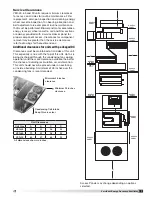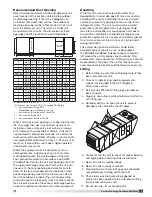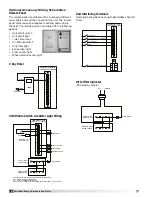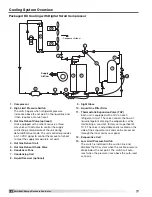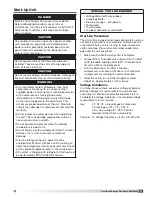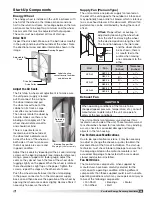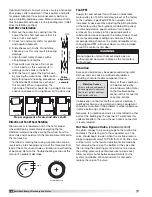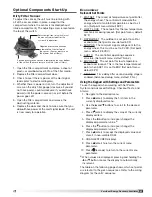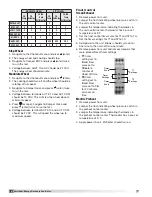
18
VersiVent Energy Recovery Ventilator
Frost Control
Extremely cold outdoor air temperatures can cause
moisture condensation and frosting on the energy
recovery wheel. Frost control is an optional feature that
will prevent/control wheel frosting. Three options are
available:
1. Timed exhaust frost control
2. Electric preheat frost control
3. Modulating wheel frost control
All of these options are provided with a thermodisc
mounted in the outdoor air intake compartment and a
pressure sensor to monitor pressure drop across the
energy wheel.
An outdoor air temperature of below 5
°
F and an
increase in pressure drop would indicate that frost is
occurring. Both the pressure sensor and the outdoor air
thermodisc must trigger in order to initiate frost control.
The two sensors together ensure that frost control is
only initiated during a real frost condition.
Timed exhaust frost control
includes a timer in
addition to the thermodisc and wheel pressure sensor.
When timed exhaust frost control is initiated, the timer
will turn the supply blower off. Time exhaust using
default timer setting will shut down the supply fan for
5 minutes every 30 minutes to allow exhaust to defrost
energy wheel. Use the test procedure in the Optional
Components Start-Up section for troubleshooting.
Electric preheat frost control
includes an electric
heater (at outdoor air intake) in addition to the
thermodisc and pressure sensor on wheel. When
electric preheat frost control is initiated, the electric
preheater will turn on and warm the air entering the
energy wheel to avoid frosting. Use the test procedure
in the Optional Components Start-Up section for
troubleshooting.
Modulating wheel frost control
includes a variable
frequency drive (VFD) in addition to the thermodisc and
pressure sensor. When modulating wheel frost control
is initiated, the VFD will reduce the speed of the wheel.
Reducing the speed of the energy wheel reduces its
effectiveness, which keeps the exhaust air condition
from reaching saturation, thus, eliminating condensation
and frosting. If the outdoor air temperature is greater
than the frost threshold temperature OR the pressure
differential is less than the set point, the wheel will run
at full speed. If the outdoor air temperature is less than
5
°
F
AND
the pressure differential is greater than the
set point, the wheel will run at reduced speed until the
pressure differential falls below the set point. The VFD
will be fully programmed at the factory.
Variable Frequency Drives (VFD)
Variable frequency drives are used to control the speed
of the fan as either multi-speed or modulating control.
Multi-speed VFDs reference a contact which can be
made by a switch or a sensor with a satisfied set point.
Modulating control references a 2-10 VDC signal to the
VFD which will vary the fan speed from a minimum 50%
to full 100% rpm. An optional CO
2
sensor is available to
provide both a set point contact or a modulating 2-10
VDC signal.
CO
2
Sensor
This accessory is often used in Demand Control
Ventilation (DCV) applications. The factory-provided
sensors can either be set to reference a set point
for multi-speed operation, or output a 2-10 VDC
signal to modulate the fan speed. These can either
be shipped loose to mount in the ductwork, or can
be factory-mounted in the return air intake. Follow
instructions supplied with sensor for installation and
wiring details.
Phase Monitor
The unit control circuitry includes a phase monitor that
constantly checks for phase reversal or loss of phase.
When a fault is detected, it cuts off the 24 VAC that
goes to the low voltage terminal strip, thereby shutting
down the unit.
Rotation Sensor
The rotation sensor monitors energy wheel rotation. If
the wheel should stop rotating, the sensor will close a
set of contacts in the unit control center. Field-wiring of
a light (or other alarm) between terminals R and 12 in
the unit control center will notify maintenance personnel
when a failure has occurred.
Dirty Filter Sensor
Dirty filter sensors monitor pressure drop across the
outdoor air filters, exhaust air filters, or both. If the
pressure drop across the filters exceeds the set point,
the sensor will close a set of contacts in the unit control
center. Field-wiring of a light (or other alarm) to these
contacts will notify maintenance personnel when
filters need to be replaced. The switch has not been
set at the factory due to external system losses that
will affect the switch. This switch will need minor field
adjustments after the unit has been installed with all
ductwork complete. The dirty filter switch is mounted in
the exhaust inlet compartment next to the unit control
center or in unit control center.




